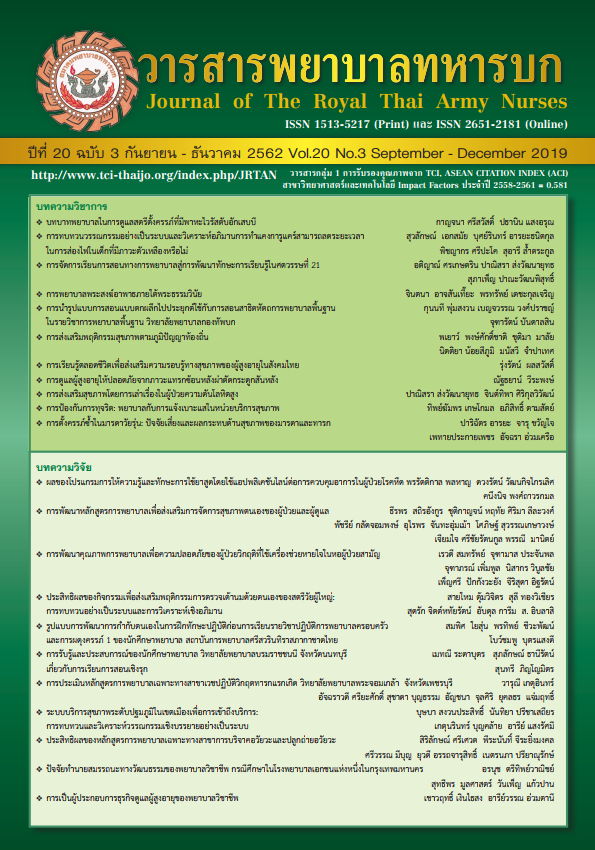Development of Program to Promote Attention Based on Neuro-Linguistic Programming in Primary School Students
Keywords:
Neuro-Linguistic Programming, AttentionAbstract
The aims of this research were to develop the enhancement of attention based on NLP program for primary school student, and to test the effectiveness of the enhancement of attention based on NLP program for primary school students. The sample consisted of 52 elementary student grade 4th-6th at BANPLAIKHLONG 20 School, Chachoengsao province. The sample was selected by PANT use reaction time max 52 persons. The sample was randomly assigned into two groups: experimental and control group, each group consisted of 26 students. The research instruments were; 1) The enhancement of attention based on NLP program for primary school students, which was developed by the researcher, 2) PEBL Attention Network Test (PANT) 3) The Wisconsin card sorting (WCST-64). The experimental group received the attention enhance program with NLP for primary students. The experiment lasted for 4 sessions, one session in each week. Each session lasted for 50 minutes. The control group joined the regular school’s activities. The assessments were done in 3 phases: pre-test, post-test and follow-up. The data were analyzed by a repeated measures analysis of variance and paired-different test by Bonferroni method.
The results revealed that; 1) there was the interaction between the experimental methodology and the duration of the experiment were found statistically significant at .05 level. 2) The experimental group had the mean score of atttention higher than those in the control group in the post-test and follow-up with statistically significant at .05 level. 3) The experimental group had the mean score of attention in the post-test and follow-up higher than the pre-test with statistically significant at .05 level. It was concluded that the attention enhancement program with NLP had the effect on enhancing attention among primary students.
References
2. Heanjohn, J., Sirithadakunlaphat, S., & Supwirapakorn, W. Development of trainging program on promoting executive function of the brain in adolescents. Journal of The Royal Thai Army Nurses 2018;19(2):220-30. (in Thai)
3. Kumlerd, S., Haenjohn J., & Supwirapakorn, W. Development of problem solving training program based on acceptance and commitment therapy in adolescents and young adults with amphetamine addiction. Journal of The Royal Thai Army Nurses 2019;20(1):181-87. (in Thai)
4. Haenjohn, J. Cognitive psychology, Bangkok, Grandpoint, 2018 b. (in Thai)
5. Petersen SE, Posner MI. The attention system of the human brain: 20 years after. Annual review of neuroscience 2012;35:73-89.
6. Siripornpanich V. Evaluation of attention using eletroencephalography and application in children with attention deficit hyperactivity disorder. Journal of medicine and health sciences 2013;20(1):4-12. (in Thai)
7. Piyasil, V., & Wangtan, S. Learning Disorders and comorbidity. Journal of the psychiatric association of Thailand. 2015; 60(4):287-296. (in Thai)
8. Mueller ST, Piper BJ. The Psychology Experiment Building Language (PEBL) and PEBL Test Battery. J Neurosci Methods. 2014;222:250-9.
9. Kongs, S. K., Thompson, L. L., Iverson, G. L., and Heaton, R. K. Wisconsin Card Sorting Test®-64 Card Version: Professional Manual. Odessa, FL.
Psychological Assessment Resource. 2000.
10. Howell, D.C. Statistical Methods for Psychology (6th ed). Australia:Thomson/Wadsworth, 2007.
11. Haenjohn, J. Neuro-linguistic programming [NLP]: application for counseling, learning, and Business: Chonburi, Get Good Creation; 2014. (in Thai)
12. Carey, J., Churches R., Hutchinson G., Jones J., & Tosey P. Neuro-linguistic programming and learning : teacher case studies on the impact
of NLP in education. United Kingdom: CIBT Education Trust; 2010.
13. Florina, G. E., Teodor, G. V., Cornelia, P. S., & Marin, D. Neurolinguistic programming and the relationship between attention and anxiety in alpine skiing juniors. Procedia - social and behavioral sciences 2015;191;1634-38.
14. Sailuenam P. The effects of neuro linguistic programming on anxiety of freshmen undergraduste students faculty of eduction. M. Sc. Chonburi: Burapha University; 2016 (in Thai)
15. Kudliskis, V., & Burden, R. Applying ‘what works’ in psychology to enhancing examination success in schools: The potential contribution of NLP. Thinking skills and creativity 2009;4(3):170-7
16. Ahmad ZK, Improving emotional intelligence (EI) using Neuro linguistic programming (NLP) techniques. In K.Z. Ahmad, International conference on advances in business management and law-2017:172-182
Downloads
Published
How to Cite
Issue
Section
License
บทความหรือข้อคิดเห็นใดใดที่ปรากฏในวารสารพยาบาลทหารบกเป็นวรรณกรรมของผู้เขียน ซึ่งบรรณาธิการหรือสมาคมพยาบาลทหารบก ไม่จำเป็นต้องเห็นด้วย
บทความที่ได้รับการตีพิมพ์เป็นลิขสิทธิ์ของวารสารพยาบาลทหารบก
The ideas and opinions expressed in the Journal of The Royal Thai Army Nurses are those of the authors and not necessarily those
of the editor or Royal Thai Army Nurses Association.





